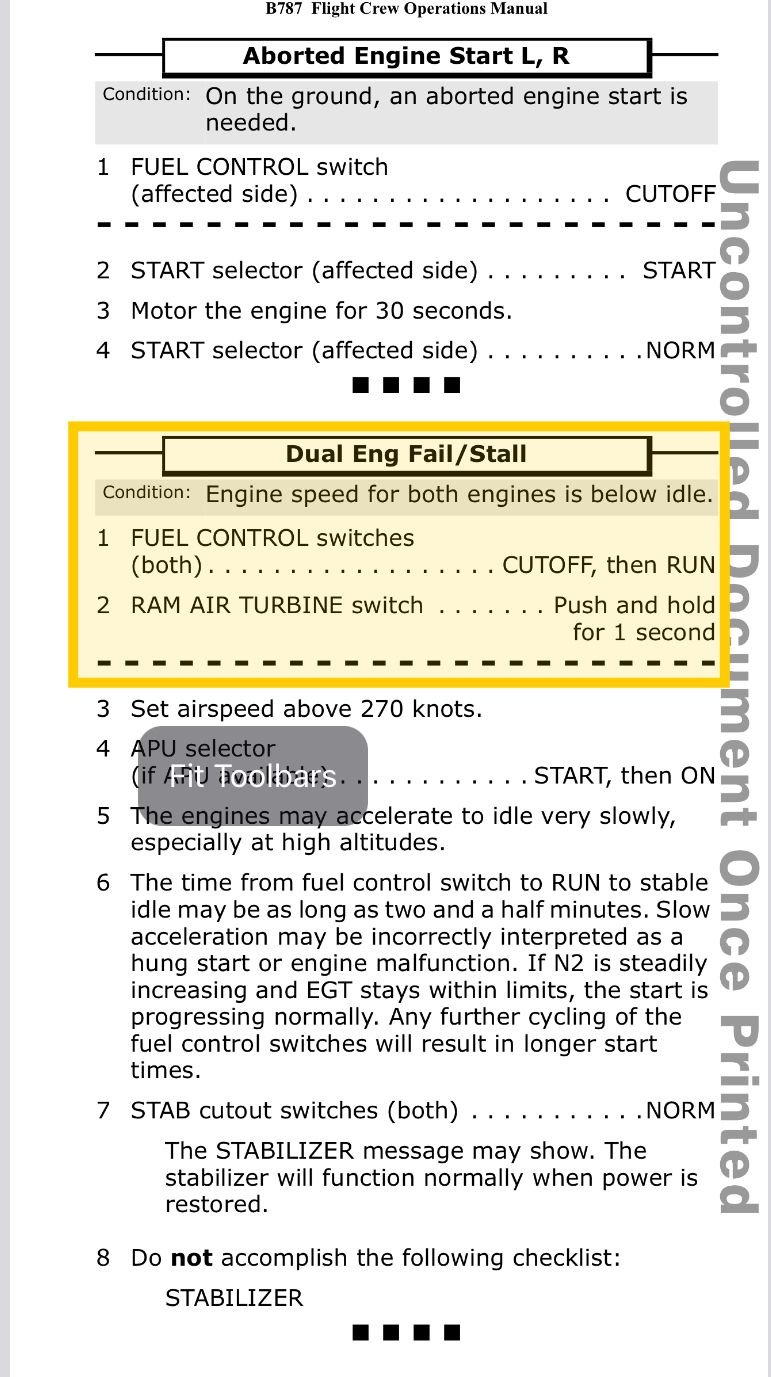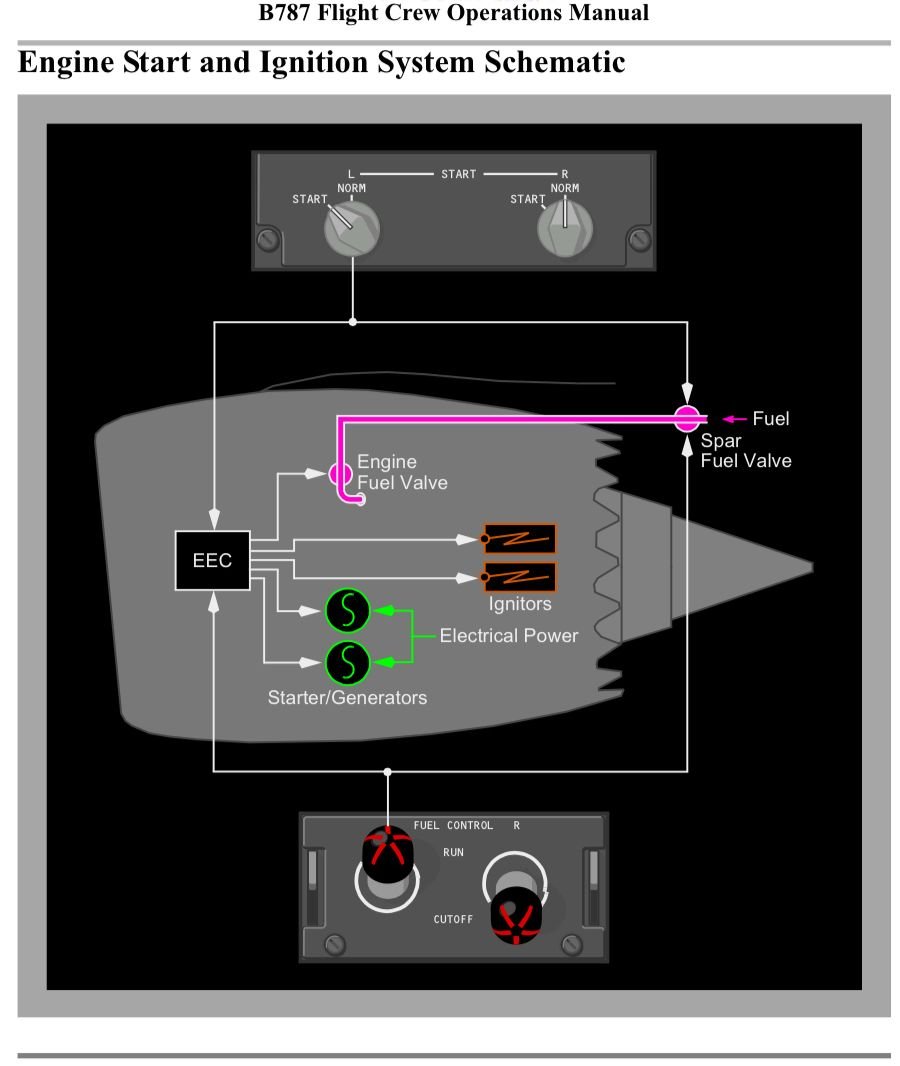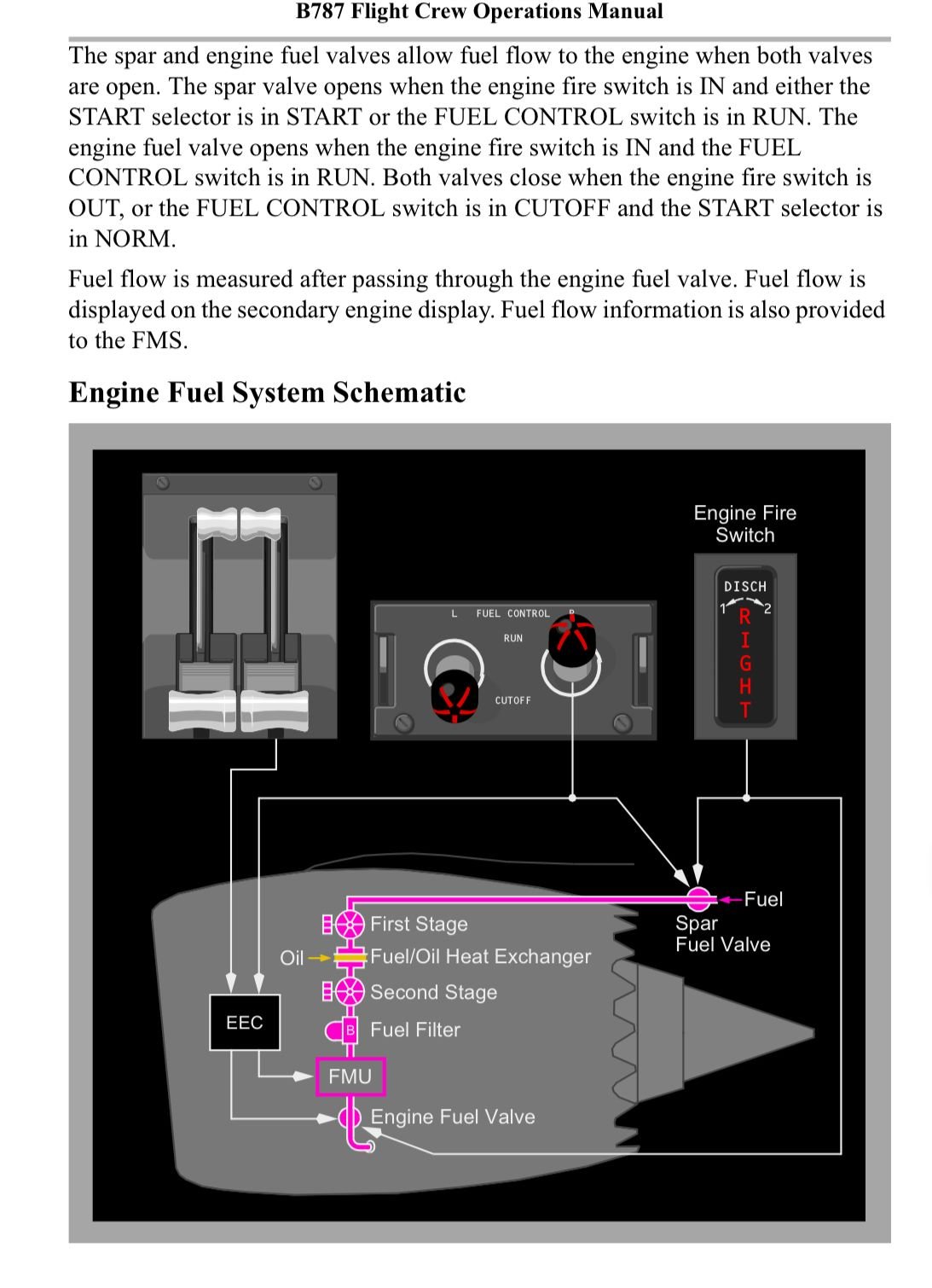July 10, 2025, 10:36:00 GMT
permalink Post: 11918879
D Bru : if that were actually the scenario, would they not instead be focusing on why "for some extraordinary reason [they were] confronted with both engines out on lift off", rather than having "narrowed its focus to the movement of the plane's fuel control switches", which would just be a side effect not a root cause?
But this is starting to devolve into a hamster wheel again.
Anyway, the other thread is open at the moment, maybe this should be moved there.
Subjects
Fuel (All)
Fuel Cutoff Switches
Links are to this post in the relevant subject page so that this post can be seen in context.
The thread is closed so there are no user likes are available and no reply is possible.
July 10, 2025, 10:59:00 GMT
permalink Post: 11918893
Condition: Engine speed for both engines is below idle
Fuel Control Switches (both) \x85 CUTOFF then RUN
RAM AIR TURBINE switch \x85 Push and hold for1 second
Subjects
Fuel (All)
Fuel Cutoff Switches
Memory Items
RUN/CUTOFF
Links are to this post in the relevant subject page so that this post can be seen in context.
The thread is closed so there are no user likes are available and no reply is possible.
July 10, 2025, 12:12:00 GMT
permalink Post: 11918942
Subjects
Fuel (All)
Fuel Cutoff Switches
Links are to this post in the relevant subject page so that this post can be seen in context.
The thread is closed so there are no user likes are available and no reply is possible.
July 10, 2025, 12:14:00 GMT
permalink Post: 11918946
Condition: Engine speed for both engines is below idle
Fuel Control Switches (both) \x85 CUTOFF then RUN
RAM AIR TURBINE switch \x85 Push and hold for1 second

Subjects
Fuel (All)
Fuel Cutoff Switches
Memory Items
RUN/CUTOFF
Links are to this post in the relevant subject page so that this post can be seen in context.
The thread is closed so there are no user likes are available and no reply is possible.
July 10, 2025, 12:42:00 GMT
permalink Post: 11918961
The above checklist procedure implies throttle lever angle and cutoff switches are independant for resetting FADECs.
If so, is it time for this convention from the days where throttles and cutoffs were mechanical systems, not resolvers and switches, to end?
Risk vs reward? Requires more coordination between PF and PM in cases where cutoff is not desired by PF- keep throttle/s up, cannot be surprised by a fuel cutoff.
Last edited by moosepileit; 10th July 2025 at 12:53 .
Subjects
Fuel (All)
Fuel Cutoff
Fuel Cutoff Switches
Links are to this post in the relevant subject page so that this post can be seen in context.
The thread is closed so there are no user likes are available and no reply is possible.
July 10, 2025, 12:53:00 GMT
permalink Post: 11918969
The above checklist procedure implies throttle lever angle and cutoff switches are independant for resetting FADECs.
If so, is it time for this convention from the days where throttles and cutoffs were mechanical systems, not resolvers and switches, to end?
Subjects
Fuel (All)
Fuel Cutoff
Fuel Cutoff Switches
Links are to this post in the relevant subject page so that this post can be seen in context.
The thread is closed so there are no user likes are available and no reply is possible.
July 10, 2025, 12:58:00 GMT
permalink Post: 11918976
The above checklist procedure implies throttle lever angle and cutoff switches are independant for resetting FADECs.
If so, is it time for this convention from the days where throttles and cutoffs were mechanical systems, not resolvers and switches, to end?
Risk vs reward? Requires more coordination between PF and PM in cases where cutoff is not desired by PF- keep throttle/s up, cannot be surprised by a fuel cutoff.

Subjects
Fuel (All)
Fuel Cutoff
Fuel Cutoff Switches
Spar Valves
Links are to this post in the relevant subject page so that this post can be seen in context.
The thread is closed so there are no user likes are available and no reply is possible.
July 10, 2025, 13:31:00 GMT
permalink Post: 11918989
The switch itself is 4-pole, or a double-on, double-on switch, capable of independentently signaling whrough completely isolated poles. The plot thickens. IF the switches really are involved, there is either some kind of shortcut in within the LRU/very messed up witing harness, some freak automated muscle memory thing or deliberate action.
Subjects
Fuel (All)
Fuel Cutoff
Fuel Cutoff Switches
Muscle Memory
Spar Valves
Links are to this post in the relevant subject page so that this post can be seen in context.
The thread is closed so there are no user likes are available and no reply is possible.
July 10, 2025, 13:33:00 GMT
permalink Post: 11918993
Worst case, at next idle TLA, engine shuts down. I bet eyes go to cutoff switches after a scan, surely EICAS/ECAM has a Captain Obvious alert set.
Runaway RPM or locked RPM, some FADECS latch at 86 or so % N1- you'd still need TLA of idle for the cut off switch to work.
Volcanic ash, loss of all engines, desire the simultaneous FADEC reset of cycling the cutoffs- just coordinate with PM for idle TLA.
Other jets have this standard, today.
Who flies the throttles in normal? PF
Who typically performs the steps, including idle TLA of shutdown/restart in flight? PM.
Last edited by moosepileit; 10th July 2025 at 13:46 .
Subjects
FADEC
Fuel (All)
Fuel Cutoff Switches
Spar Valves
TLA (Thrust Lever Angle)
Links are to this post in the relevant subject page so that this post can be seen in context.
The thread is closed so there are no user likes are available and no reply is possible.
July 10, 2025, 14:04:00 GMT
permalink Post: 11919015
Changes:
- Built the thread up to July 10, 2025, 12:31:00
- Add subjects: Relight, 51 Day Issue, Fuel Cutoff Switches (detent), ICAO, Fuel Cutoff Switches, Memory Items, Annex 13, Simulation Scenarios.
- Various technical fixes should give a better/more accurate presentation.
Raise issues here https://github.com/paulross/pprune-threads/issues or PM me.
Subjects
Annex 13
Fuel (All)
Fuel Cutoff
Fuel Cutoff Switches
Fuel Cutoff Switches (detent)
ICAO
Memory Items
Relight
Simulation Scenarios
Links are to this post in the relevant subject page so that this post can be seen in context.
The thread is closed so there are no user likes are available and no reply is possible.
July 10, 2025, 14:18:00 GMT
permalink Post: 11919024
- They know exactly 1 fuel switch was cut off, perhaps implying single engine failure + wrong engine shutdown
- They know 1 or both switches were cycled off then on, implying a last-ditch attempt at some sort reset at any point up to say ~30s
- They know both fuel switches were cut off, and remained off, implying sabotage
- If the cut off happened within 20s of leaving the ground perhaps it could explain why CCTV shows the initial climb then level for ~10s before descent. It could also explain the RAT and gear trucks perhaps if gear up was delayed? However, in this scenario they must know that the engine failed, that information would be clearly recorded and surely the leak would lead with that info? Also 'switches' is plural implying both, the radio call didn't mention single engine failure and like you say its quite hasty, even within 20s.
- Again assuming switches plural, this implies either of the prevailing theories of dual engine failure leading to loss of AC or loss of AC leading to reduced thrust or engine failure. However, it also seems strange to lead with that info rather than the state of the engines or electrical systems in any flight data, unless someone can explain how the data would be impacted?
- If this was the case then it would imply that there is no voice or engine data to explain the cut off, nothing was said and the engines were normal up until that point
Subjects
CCTV
Dual Engine Failure
Engine Failure (All)
Engine Shutdown
Fuel (All)
Fuel Cutoff Switches
MAYDAY
RAT (All)
Links are to this post in the relevant subject page so that this post can be seen in context.
The thread is closed so there are no user likes are available and no reply is possible.
July 10, 2025, 14:33:00 GMT
permalink Post: 11919031
Subjects
Fuel (All)
Fuel Cutoff Switches
Spar Valves
Links are to this post in the relevant subject page so that this post can be seen in context.
The thread is closed so there are no user likes are available and no reply is possible.
July 10, 2025, 14:45:00 GMT
permalink Post: 11919035
Subjects
Fuel (All)
Fuel Cutoff
Fuel Cutoff Switches
Spar Valves
TLA (Thrust Lever Angle)
Links are to this post in the relevant subject page so that this post can be seen in context.
The thread is closed so there are no user likes are available and no reply is possible.
July 10, 2025, 14:58:00 GMT
permalink Post: 11919040


Subjects
Fuel (All)
Fuel Cutoff Switches
Spar Valves
Links are to this post in the relevant subject page so that this post can be seen in context.
The thread is closed so there are no user likes are available and no reply is possible.
July 10, 2025, 16:10:00 GMT
permalink Post: 11919084
I'm trying to mix the best of the old and the new.
Fast, erroneous, uncoordinated or nefarious- gives a way to intervene, without changing the standards.
Throttles are no longer mechanical. Keep them forward off idle and the cutoff switch does nothing.
Fire/fail/flameout/stall- PM takes the confirmed bad throttle to idle. Then, if appropriate, fuel cutoff and then continue with the fire switch that should also isolate fuel before the engine, air, hydraulics, and electrics.
Bias- I've had mechanical fuel cutoff, mechanical throttles and mechanical isolations- DC9.
Electric throttles, fuel cutoffs and mechanical isolations- C-17s and MD-11s.
Have not had all electrical on switches, throttles and electrical circuits for isolation, only- which allows for more options and unintended consequences.
Last edited by moosepileit; 10th July 2025 at 16:24 .
Subjects
Fuel (All)
Fuel Cutoff
Fuel Cutoff Switches
Spar Valves
Links are to this post in the relevant subject page so that this post can be seen in context.
The thread is closed so there are no user likes are available and no reply is possible.
July 10, 2025, 16:53:00 GMT
permalink Post: 11919101
That does not mean that the pilots "out of habit" would have reverted to the procedure. Who would not? But in that case, the fuel control switches would be found in the RUN position post crash (if anything was left). So did they find the switches in the cutoff position, or did the action of switching got "stored" somewhere in FDM (not a specialist on these things, only to hear many times in the past that "maintenance is already aware" if we had an issue and called maintenance post flight)
Subjects
Dual Engine Failure
Engine Failure (All)
FCOM
Fuel (All)
Fuel Cutoff Switches
RUN/CUTOFF
Links are to this post in the relevant subject page so that this post can be seen in context.
The thread is closed so there are no user likes are available and no reply is possible.
July 10, 2025, 16:55:00 GMT
permalink Post: 11919105
That functional separation exists on MD-11 (for which I see you are rated) but not for 777 and 787. The key difference is that MD-11 fire shut off valves (equivalent to Boeing spar valves) are mechanically operated but 777 and 787 spar valves are electrically operated.
Boeing chose to have both the HP and spar valves controlled by the fire handles AND the cut off switches.
Subjects
Fuel (All)
Fuel Cutoff Switches
Spar Valves
Links are to this post in the relevant subject page so that this post can be seen in context.
The thread is closed so there are no user likes are available and no reply is possible.
July 10, 2025, 17:08:00 GMT
permalink Post: 11919112
Viewed in light of the reported switch positions, the phrasing feels increasingly ambiguous. As is often stated on PPRunE, communication comes after aviation so you wonder why in the crisis and at low altitude, this message was transmitted. Being so atypical, the message merits re-examination.
Subjects
Fuel (All)
Fuel Cutoff Switches
MAYDAY
RUN/CUTOFF
Links are to this post in the relevant subject page so that this post can be seen in context.
The thread is closed so there are no user likes are available and no reply is possible.
July 10, 2025, 17:26:00 GMT
permalink Post: 11919126
Subjects
Fuel (All)
Fuel Cutoff
Fuel Cutoff Switches
Links are to this post in the relevant subject page so that this post can be seen in context.
The thread is closed so there are no user likes are available and no reply is possible.
July 10, 2025, 17:30:00 GMT
permalink Post: 11919130
Viewed in light of the reported switch positions, the phrasing feels increasingly ambiguous. As is often stated on PPRunE, communication comes after aviation so you wonder why in the crisis and at low altitude, this message was transmitted. Being so atypical, the message merits re-examination.
Subjects
Fuel (All)
Fuel Cutoff Switches
MAYDAY
RUN/CUTOFF
Links are to this post in the relevant subject page so that this post can be seen in context.
The thread is closed so there are no user likes are available and no reply is possible.